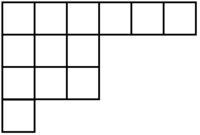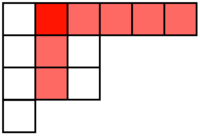Difference between revisions of "Hook Length Theorem"
(→Introduction) |
|||
| Line 3: | Line 3: | ||
[[File:Young Tableau.png|center]] | [[File:Young Tableau.png|center]] | ||
| + | |||
| + | A tableau has a decreasing(not strictly decreasing) number of blocks in every row. | ||
| + | |||
| + | [[File:Tableau.png|200px|center]] | ||
| + | |||
| + | A Standard Young Tableau(SYT) has increasing numbers in both rows and columns. As shown in the figure, 1-3-10 is increasing, as well as 2-5, 4-6, 7-9, 1-2-4-7-8, and 3-5-6-9. | ||
| + | |||
| + | |||
| + | =Theorem= | ||
| + | Let the number of blocks in the tableau be <cmath>n</cmath>. A hook of a block is the number of blocks to the right and below the block, including the block. | ||
| + | |||
| + | [[File:Hook Example.png|200px|center]] | ||
| + | |||
| + | The Hook Length Theorem states that the number of SYTs is <math></math>\frac{ | ||
Revision as of 21:45, 5 November 2022
Introduction
The hook length theorem is a theorem to be used on Standard Young Tableau. A standard Young Tableau is essentially a pack of blocks together, such as this one:
A tableau has a decreasing(not strictly decreasing) number of blocks in every row.
A Standard Young Tableau(SYT) has increasing numbers in both rows and columns. As shown in the figure, 1-3-10 is increasing, as well as 2-5, 4-6, 7-9, 1-2-4-7-8, and 3-5-6-9.
Theorem
Let the number of blocks in the tableau be ![]() . A hook of a block is the number of blocks to the right and below the block, including the block.
. A hook of a block is the number of blocks to the right and below the block, including the block.
The Hook Length Theorem states that the number of SYTs is $$ (Error compiling LaTeX. Unknown error_msg)\frac{












